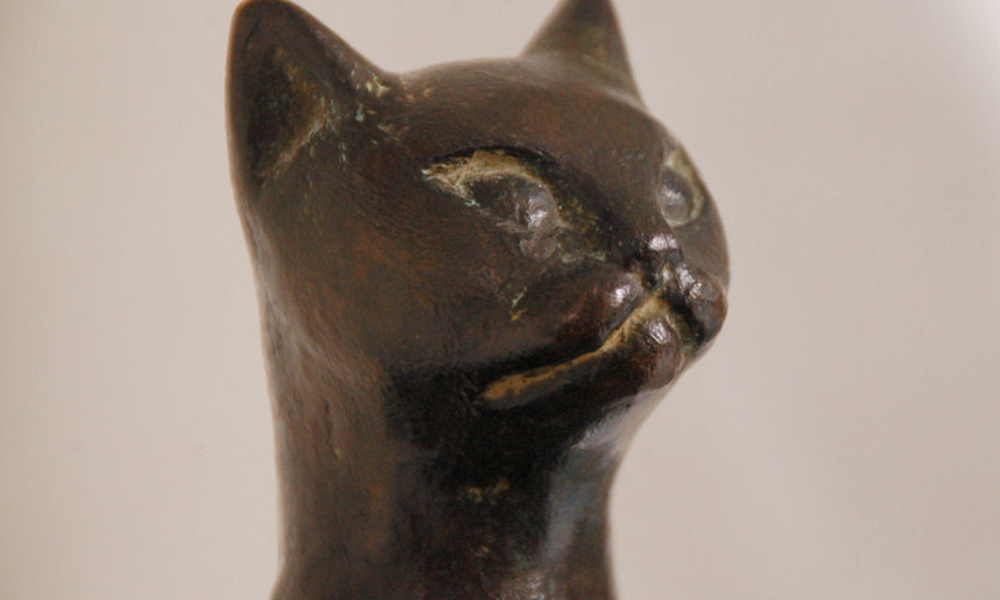The author reexamines the famous proceedings that principally related to counterfeits of the works of Diego Giacometti brought in the Besançon Court of Appeal in November 1998 and the still current repercussions of the case.
Article de la Revue Experts n° 71, juin 2006 © Revue Experts
On 15 July 1985, Diego Giacometti died of a cerebral embolism. Three days before, he had had a success cataract operation performed in Neuilly-sur-Seine that should have enabled him to again appreciate the details that make the difference between what is ordinary, what is beautiful and what is perfect.
Another satisfaction greeted him on leaving the hospital: the installation of his works in the Picasso Museum ordered by the State (by the National Treasures, at the time directed by Jean Coural) in the Hotel Salé in Paris. The inauguration of the Museum took place on 24 September 1985 and Diego’s art at last left the muffled apartments of the erudite and visionaries of the era.
The shock was significant. The whole world discovered the brilliant, recently deceased artist, who had remained discreet all his life. This brilliant display at the Hotel Salé projected the works of Diego Giacometti, who had for too long remained in the shadow of his brother Alberto, to centre stage. His popularity soared within a period of several weeks. The ascension was vertiginous. No longer did people talk of furniture but works of art: nowhere could they be found… The balance between supply and demand could not be reestablished because Diego had stipulated that after his death, no work, whether original or copy, would be produced, as the law authorized, except in the event of a contrary provision by the deceased, his heirs and successors.
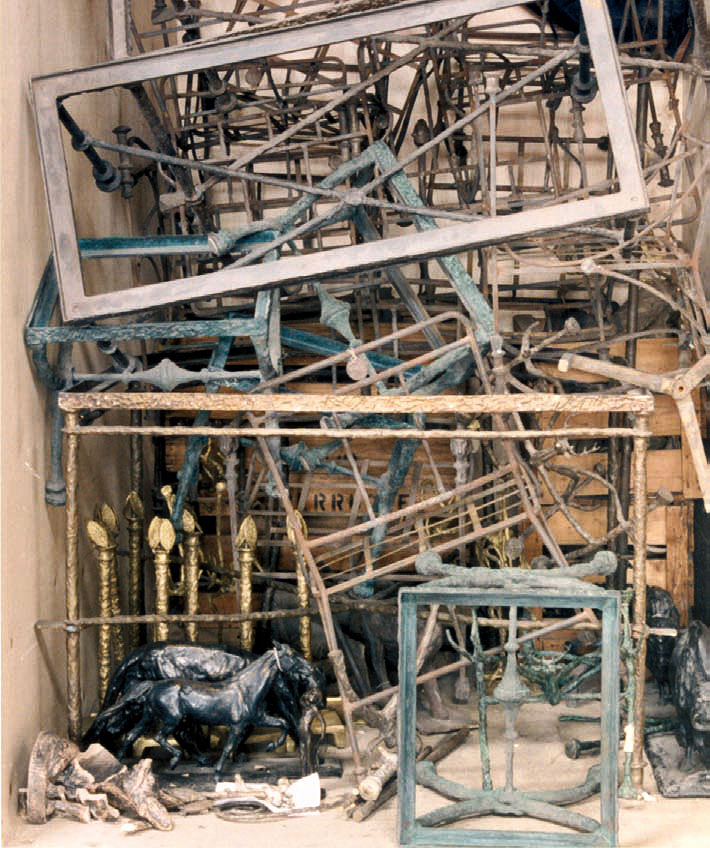 • Container no. 846 containing counterfeits of the works of Diego Giacometti in April 2003 prior to destruction.. The enlightened amateur will note the animal works on the ground (1), in the style of E. Sandoz, I. Bonheur and R. Bugatti.
• Container no. 846 containing counterfeits of the works of Diego Giacometti in April 2003 prior to destruction.. The enlightened amateur will note the animal works on the ground (1), in the style of E. Sandoz, I. Bonheur and R. Bugatti.
1. THE FOUNDRIES USED BY DIEGO
During his creative life, Diego used a number of foundries, without keeping precise archives, ordering parts for his furniture or decorative animals that he himself assembled.
The first casting that we know of dates from an order made in 1933, a headless lamp from the Alexis Rudier foundry, a work produced in collaboration with his brother Alberto. The Giacometti brothers stopped using this foundry in 1952 on the death of its manager, Eugène Rudier. The E. Aubert Foundry, located in the Rue des Vertus in the 3rd Arrondissement in Paris, appears to have been the first foundry used by the independent Diego, from 1952, to cast, in particular the Cat Butler. The foundry closed on the death of its manager in 1977. The Swiss foundry had previously been used by Alberto, it naturally produced the major part of Diego’s work until 1975 (the current manager of the foundry remains unsure of this date, being within two years either side of the actual date). The Thinot foundry then took over the major part of the productions of the Cat Butler, the Ostriches and several tables from 1977 until the artist’s death.
Three art foundries produced the artist’s work after his death. The Boivin foundry in Paris, the Thinot foundry in Châtillonsous-Bagneux, in the south side of Paris, and the Jacques Redoutey foundry in Port-sur-Saône in the Haute-Saône Department.
When Jean Coural sent the order on behalf of the Picasso Museum, the sum available exceeded the cost of production by the Swiss foundry, considered to be amongst one of the best foundries in the world but also known for the cost of its quality. The Thinot foundry, on the other hand, did not have sufficient capacity to ensure this substantial order. Diego therefore turned to the numerous foundries that, since the beginning of the 19th century, had been set up in the east of France, the costs of production for which were at least one-half of those in the capital. Casts for the Hotel Salé furniture were therefore completed using the Jacques Redoutey foundry, Diego leaving, as was his habit, the assembling to two of his workers.
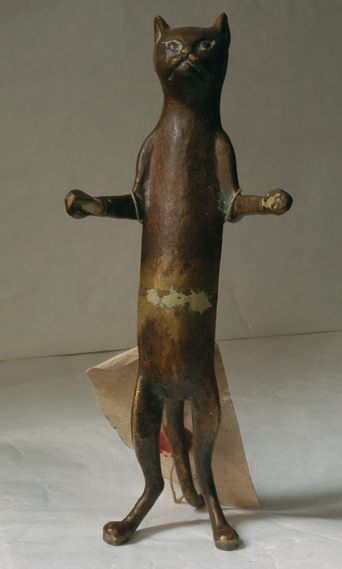 • Cat Butler, bronze original produced by the Swiss foundry. Cut into three pieces by the counterfeiters – base, plate and animal – in order to serve as a master model for the counterfeiter using the multiple piece sand-casting technique.
• Cat Butler, bronze original produced by the Swiss foundry. Cut into three pieces by the counterfeiters – base, plate and animal – in order to serve as a master model for the counterfeiter using the multiple piece sand-casting technique.
2. THE FOUNDRY’S APPROACH
The death of Diego in his full glory thus created a penury in his works and accentuated the frenzy by art amateurs and investors. With demand persisting, some individuals decided to fill the void in the market. These unscrupulous individuals attempted to woo the Swiss and Thinot foundries, without success. The reception was different 400 km from the capital, in a region where the industry was suffering and the furnace fires extinguishing over the decades. As a consequence of this recession, employee and tax charges accumulated. Smaller foundries hung on, fearing insolvency. The hard labour required when faced with glowing bronze being poured from a melting pot, the resulting high temperature making a man sweat and thirsty was their daily lot that they would not (could not?) abandon. Only their labour of love enabled them to support the deterioration in their conditions.
It was not difficult to flatter their courage then demonstrate that their so badly paid work served merely to make white-collar Parisians richer:
“What, having produced this Table Frame (low table model attributed to Diego) for €4,000, you didn’t know that it had been sold in Paris for €200,000?…”. An occasional table in owl motif involved in the court proceedings, bought from one of the receivers of the counterfeit goods for 40,000 FF found a buyer at the end of 1985 at Christie’s New York for 378,000 FF on 25 March 1986!
The prospecter, having distilled his rancour, then brought out the antidote: “Without you, the artist would exist only in relation to the design, the models and the copies and plaster! It is you, the founder, who was the true creator of the work! The artist, the art dealers, the collectors, live off your sweat! The proof is here because you hold the models! You can continue to release the artist’s work without the artist and nobody will know the difference!…”. The master founder would have his revenge; the ‘broker’ would deal with the legality of the operation and sales.
3. THE PRODUCTION OF COUNTERFEITS
This association lasted for four years, the J. R. foundry paying its social security, retirement and taxes, then became prosperous…
Nevertheless, close friends of Diego and his brother Bruno, his sister-in-law Annette, the widow of Alberto, and his nephew was surprised to see works by Diego constantly appearing in auction houses both in France and the United States. The art world is a small world, that of foundries even smaller, the competition is tough and each keeps an eye on his competitors. Questions are asked of the looser tongued suppliers of the raw materials, the apprentices, the workers. It did not take long for suspicions to fall on a foundry in Port-sur-Saône.
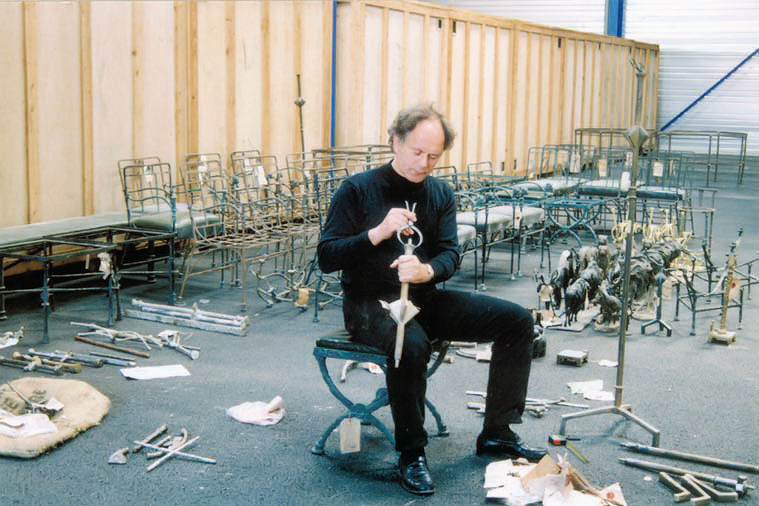 • Expert analysis of an original star-studded lamp, cut up and modified to serve as a master model for counterfeiters then a selection of seized works (April 2003).
• Expert analysis of an original star-studded lamp, cut up and modified to serve as a master model for counterfeiters then a selection of seized works (April 2003).
4. THE INVESTIGATION
An investigation was commenced in mid-1989 by an investigating judge at the Besançon Regional Court. Telephone tapping revealed the amplitude of the network and its ramifications. The criminal police moved into action on 12 October 1989 by searching the gallery run by A. P. at 15 rue de Miromesnil in Paris. The investigators discovered, an addition to invoices for 10 works, 3 bronzes by Diego Giacometti.
Sometime later, Inspector Vincenot of the research section of the Dijon criminal police recovered other works that had been placed either with experts in order to obtain their opinion on authenticity or with an auctioneer in order to be sold. All came from a foundry in Port-sur-Saône via an intermediary, R. D., who was paid in cash. Interviewed by the investigators on 13 October 1989, the latter referred to himself as an ‘art foundry consultant’.
Thanks to exemplary teamwork between the various authorities in question, the investigation was efficient, rapid and contained sufficient proof for the court then the Court of Appeal to issue their relevant judgments and orders. Three networks were highlighted in relation to two foundries.
The counterfeiting of bronzes requires the foundry to hold a model from the artist in question. It is easy, therefore, to understand the importance for the courts to find the source for the models in order to determine liabilities. The reasons contained in the judgment of October 2000 clarified the manner in which the ‘foundry consultant’ procured models that were not in the order placed by the Picasso Museum: he bought original works or traded counterfeits in order to obtain them. On 26 April 1990, he explained to the criminal police investigators: “I exchanged Phoenician and Venetian objects that I possessed with M.V. … I gave him those in exchange for the two tables and the ostrich (2)…” (D1111/3, p. 4). This false trail was later denied, partly because the works were counterfeits and partly, M. V. having subsequently died, because his brother confirmed that he had never been in possession of works by Diego.
On 19 March 1991, the investigating judge Dominique Martin-Saint-Léon organized a confrontation between the “best connoisseurs of the works of Diego Giacometti, ie, the foundries and the persons who had worked for the artist in assembling the works, François Mons and Pierre Boulanger, from Diego’s workshop, and Pierre Thinot and Jean-Jacques Laurent, founders (manager of the Boivin Foundry in Paris) and a sculptor friend of Diego’s, Philippe Anthonioz, not forgetting David Marchesseau, who had written the sole, leading, book on the works of Diego Giacometti.” The latter found that the works seized from A. P. were imitations. This was their finding, not an expert report.
5. FIRST NETWORK
In 1985, the foundry in Port-sur-Saône that had produced the works for Hotel Salé went into court administration and
“J. R., who was his company’s guarantor in relation to the financial institutions, had his house sold at public auction on 17 December 1985 (3).” The land was, therefore, favourable for any bad seed to attempt to redress the situation.
The first network was created by the tandem R. D. and his friend A. P., who contacted J. R.’s foundry. The police search carried out on 10 March 1989 at his foundry enabled the seizure of a dozen chairs, two tables, all signed by Diego, and “in the factory, numerous works in the process of being assembled and certain items enabling the works of this artist to be assembled”.
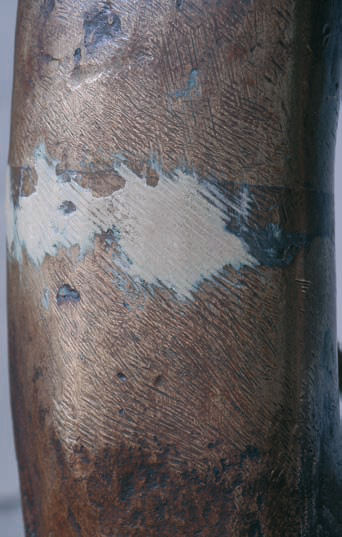
• Detail of the master model cut and extended to compensate for the dimensional reduction due to the overlaying. Visible on the counterfeit works are the extended part, which was added using a file the traces of which were not effaced, and the modification of the initial volume due to this transformation being carried out somewhat carelessly.
The founder provided certain information during the investigation enabling figures to be placed on the size of his undisclosed production of the works of Diego Giacometti produced after the death of the artist. However, this information is vague and the figures merit being increased. For example, one of the accused, an employee at the foundry, admitted “that he estimated that he had personally held in his hands at least 200 moulded items, including, for example, 100 Giacometti (Diego) chairs. From April 1987, on certain days there were six or seven of them who did only that all day (3)”. The various interviews showed that the production by the foundry between 1985 to 1989 could be estimated at 700 works and 1,000 counterfeit D. Giacometti works: only 100 were seized and destroyed…
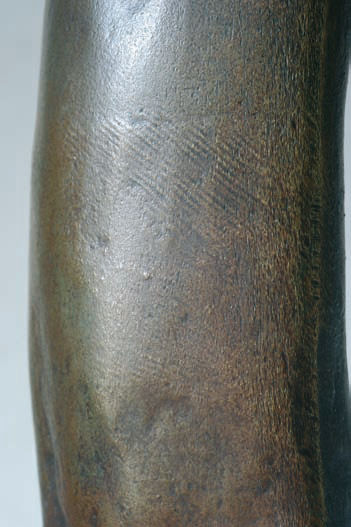
• Detailed view enabling, among other things, identification of these counterfeits. Of note in a low light is the absence of a ‘grain’ on the surface of the stomach, the sides being too sharp and the file marks on the upper extension ring on the master model modified by the counterfeiters.
6. SECOND NETWORK
As can be seen from the order issued by the Besançon Court of Appeal on 17 November 1998, these two “art dealers and gold-diggers”(4) were not the only ones to profit from the death of Diego.
Another network came to light by chance. Two young men, who worked in another foundry in the same region, began making counterfeits from time to time for their sports teacher. This manager of a physical training centre in Besançon understood the potential capital gains and contrived to improve the profit from their business. Initially this involved works by E. Sandoz, R. Bugatti, Pompon, P.J. Mêne, etc, mainly French animal sculptors of the end of the 19th century and first half of the 20th century. Later were added the Diego models used by the neighboring foundry. This network involved M. G., the physical training teacher, who set up a network to sell works produced by the two young men, P. G. and D. R. (J. R.’s nephew), who were employees at the Fodor foundry in Port-sur-Saône.
Through phone-tapping, the investigating judge soon learned, on one hand, that an auction of a dozen objects attributed to Diego Giacometti and released by an associate, J. L., was going to be held in Autun on 19 March 1989 and, on the other hand, that another associate, B. B., was going to go back to Toulouse with a van full of bronze counterfeits (attributed to the artists cited above). On 9 March 1989, the investigating judge decided to arrest B. B. when he entered the motorway for Toulouse in his van and the other suspects. This network was thus completely stopped and part of its stock seized.
The court found that “in this case, M. M. G. had been driven by an pecuniary interest, he appeared to be the person responsible for the network, ordering the objects, reselling them by not hesitating to mislead buyers or discredit the works of an author by releasing works onto the market that were often of poor quality”.
7. THIRD NETWORK
An art amateur, G. T., who was passionate about the works of Diego Giacometti and the happy owner of some of them since 1979, met J. R. in 1986 in order to repair one of Diego’s Ostriches. Passion, the bait for easy profit, brought the two men together; the founder increased his clientele by providing the art amateur with works on command.
This unscrupulous amateur, a part-time journalist, did not lose any time. He published an article in the Geneva Tribune on 22 November 1987 promoting his collection, increased by counterfeits purchased from the founder J. R., under the sensationalist title “Diego: an investment”.
The court, giving reasons for its judgment, did not fail to refer to the purpose for this article:
“It was in the interests of the sale organized on 30 November 1987 in Paris by (the auctioneers) Henri Chayette and Laurence Calmels. It related to approximately 30 works from the collection of a Parisian who had recognized the worth of Diego Giacometti’s works a long time ago…”
The publicity method through the press is classic and often successful.
The works seized by the criminal police were revealed to be imitations according to friends of the artist. But the court discovered that the accused had been careful to combine authentic works, which had also been seized, and were subsequently mixed with other works sealed by the police.
With J. R. refusing to give the names and contact details of his buyers, the investigating judge took the initiative of searching out the latter by examining national and international auctions and investigating forwarding agents. Thus, sixteen tables “bought at the Paris City Hall Bazar” were sent by R. D. to New York to be subsequently sold at Christie’s and Sotheby’s as authentic works by Diego Giacometti.
J. de V., another intermediary in this network, was indisputably another source of indisputable originals confirmed by the court; such as the table base from an auction in Paris, a lamp from another Parisian studio. Lastly, Mrs S. de K. declared that in 1977, Diego Giacometti had given her a Cat Butler and an Ostrich and that these works were then sold to J. de V. and seized by the police. This mixing of recent authentic works and counterfeits could but increase the confidence of buyers.
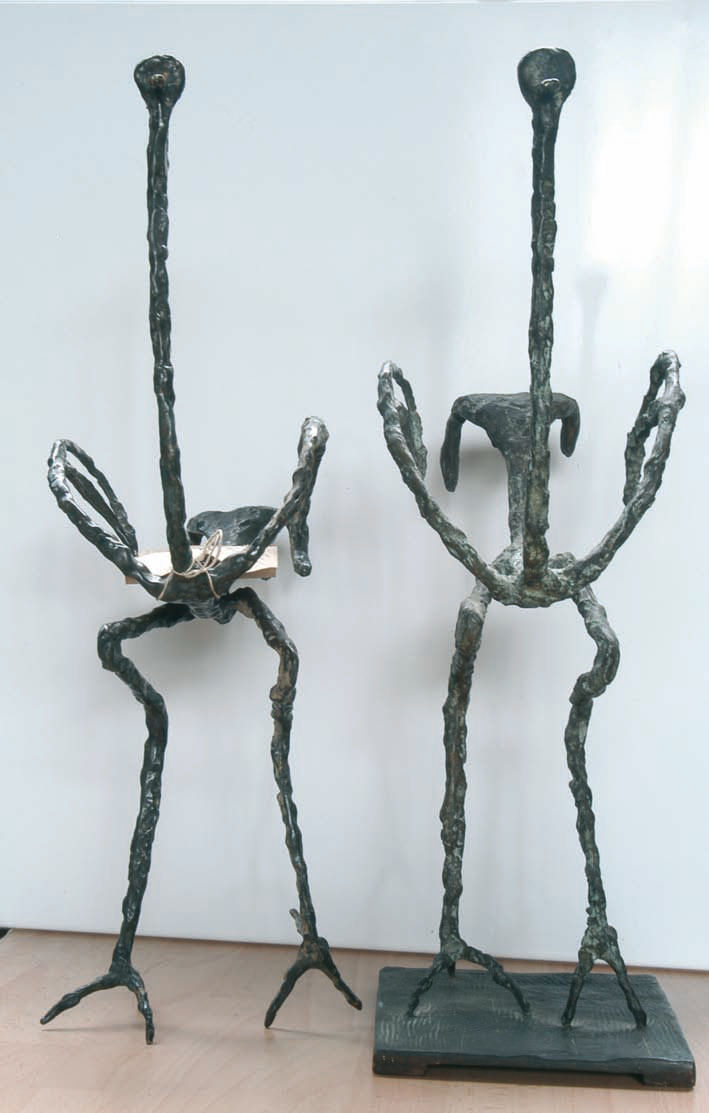 • Ostriches. To the right, a counterfeit produced by the Port-sur-Saône foundry, managed by J. R., next to an authentic copy produced by the Thinot Foundry. While the height was adjusted, the counterfeiter was not able to alter the thicknesses, which, using the overlay method, are thinner.
• Ostriches. To the right, a counterfeit produced by the Port-sur-Saône foundry, managed by J. R., next to an authentic copy produced by the Thinot Foundry. While the height was adjusted, the counterfeiter was not able to alter the thicknesses, which, using the overlay method, are thinner.
8. THE APPEAL PROCEEDINGS
The filing of an appeal before the court in Besançon ended following an order issued by the Criminal Appeals Division on 17 November 1998. It should be noted that as at this date, Diego’s brother Bruno was no longer a party to the proceedings and that he did not appear nor was he represented. His sister-in-law Annette, the wife of the celebrated sculptor Alberto, had, in the meantime, died, as had the nephew Sylvio Berthoud.
Only Thérésa Tigretti, the Berthoud widow, remained to represent the heirs of Diego. The Court, however, declared her participation as a civil party to be inadmissible, and, in its reasons, found that Annette Giacometti’s successors had not continued the proceedings and that Bruno had not taken part in the proceedings before the said court. The result was that no heir was convoked as a civil party when the counterfeit works were destroyed and the authentic works and master models were not able to be returned to them.
The Court sentenced all of the links in the network, from the master founder J. R., his associates, children, nephew and daughter-in-law as well as a dozen intermediaries to prison sentences coupled with fines.
9. THE LACK OF EXPERT EXAMINATIONS
The defense used all of the standard arguments to apply to set aside the order. One of the defense arguments in relation to one of the charges merits particular attention for experts. Mrs L. H., wife of C. d’A., contested the evidence on which the offenses were based, “claiming, among other things, that no technical expert report had been carried out. The opinion of a police officer who had monitored the prices for bronze could not be compared to an expert report (3). The overall proof was indisputable, the findings having been made by specialists nominated by Inspector Vincenot and appearing to be sufficient proof in order to avoid the costs of an expert report (5).
The Court replied that a court-appointed expert report to obtain additional information could not have been carried on the grounds that, at that time, there was no persons specializing in the artist other than Mr Marchesseau, at the time curator of the Museum of Decorative Arts in Paris and author of a book on Diego Giacometti.
“But he was connected with the civil parties and could not, therefore, be appointed as expert. Mr Marchesseau and the persons who had worked on behalf of Diego Giacometti were nevertheless heard as witnesses and had confronted the accused (3)”.
10.THE EXPERT REPORT AFTER RELEASE OF THE JUDGMENT
This was, in fact, a mistake because, when it became necessary to determine what to do with the seized stock, which filled three containers, the regional prosecutor, represented by the Advocate General, Hubert Bonin, felt obligated to order an expert report in order to separate the wheat from the chaff.
This expert report, carried out by the author of these lines, had another advantage; that of preserving the master models enabling the identification of the imitations and several original master models relating to the furniture in the Hotel Salé. Some might today see such an expense exceeding the context of the criminal justice task, because the duty of the prosecutor’s office is not to collect information on the history of art. We are keen to reassure them. The purpose of this task was to avoid authentic works mixed with the seizures being destroyed or counterfeit works being returned as originals to their owners. These risks were sufficiently high to, in themselves, justify the appointment of an expert. The result is a database, kept in the archives of the Court of Appeal in Besançon, that is accessible to all experts or art historians. The dimensions, the nature of the joints used by the foundries, the patina and the details that characterize each counterfeit work are contained in technical files in this expert report.
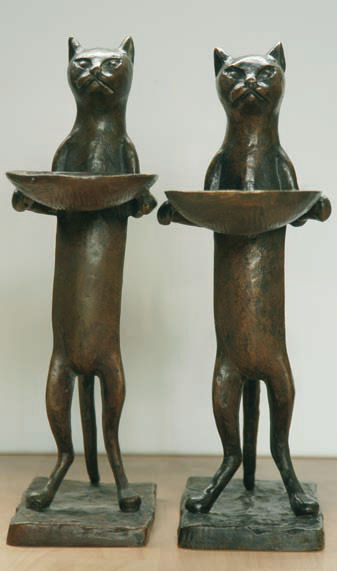 • To the left, Cat Butler, counterfeit produced by the foundry in Port-sur-Saône managed by J. R., next to an authentic copy produced by the Thinot Foundry, to the right. The counterfeit work is larger than the original work of art, which is thinner; the counterfeiter not risking to make the master model thicker. Also of note is the lack of material on the stomach of the counterfeit work and the reduced size of the platter.
• To the left, Cat Butler, counterfeit produced by the foundry in Port-sur-Saône managed by J. R., next to an authentic copy produced by the Thinot Foundry, to the right. The counterfeit work is larger than the original work of art, which is thinner; the counterfeiter not risking to make the master model thicker. Also of note is the lack of material on the stomach of the counterfeit work and the reduced size of the platter.
CONCLUSIONS
Experience proves that in most counterfeit cases, the counterfeiter does not know when to stop. The attraction of easy profit removes any desire to stop the production while there is still time. The sudden abundance of the works of an artist attracts attention and suspicion in honest professionals. The latter do not hesitate to reveal individual and sporadic counterfeits to all and sundry. But where too many imitations are presented in the market, the professionals combine and assist the authorities concerned in identifying the authors of such virus in order to stop the epidemic. This was also the situation for the famous case of Guy Hain, known as ‘The Duke of Burgundy’, where more than 2,500 bronzes were seized during an investigation also carried out by the Court of Appeal in Besançon (another was carried out after 2000 by the Créteil Regional Court, the investigation of which is still pending). The more clever counterfeiters of those who order only several works a year, acting alone with their founder associate. Two individuals involved in the works of Auguste Rodin are well known to experienced professionals. Due to limitation periods, the lack of proof or a civil party, these 70-year old counterfeiters have made a fortune and barely risk being investigated. It remains essential, however, that their production be found and quantified.
Today, the tongues of retired workers are loosening. All are aware that the splitting of profit was far from being equitable. However, in fear of reprisals and being investigated by the police, these ex-workers are not spontaneously coming forward. This is a shame for the justice system and for the history of art. In the absence of public written documents, the expert who has formally recorded a counterfeit must produce solid proof in order not to be criticized or even brought before the courts for defamation! Keeping the faith and sharing information with judges and the criminal police is required because, in addition to upholding the law, all of these measures maintain the reputation of our artists and have a recurring and very positive effect in promoting French art.
NOTES
- 1. Article L.121-2 of the (French) Code of Intellectual Property provides that: “Only the artist has the right to release his work… ». Silvio Berthoud, nephew of Diego Giacometti, and Bruno his brother, his successors, confirmed to the investigating judge responsible for the investigation in question that Diego “had clearly indicated his desire that the furniture that he had created no longer be produced after his death, he had requested that the moulds be destroyed, that the remaining pieces that had not been assembled be also destroyed and that the models be no longer used”. (D 226, 383, 804, 1247, 1695 to 1698).
- 2. Judgment No. 2684 by the Regional Court in Besançon, reserved decision of 18 October 2000.
- 3. Order by the Court of Appeal in Besançon of 17 November 1998.
- 4. Expression henceforth famous, from the title of the book written by François Duret Robert, ed. Belfond, in 1991.
- 5. Since these events, Inspector Vincenot has retired and features in the amateur edition of the International Guide to Experts and Specialists in Armand Israël as being a specialist in the works of the Giacometti brothers, A. Rodin, Pompon, E. Sandoz, etc.
